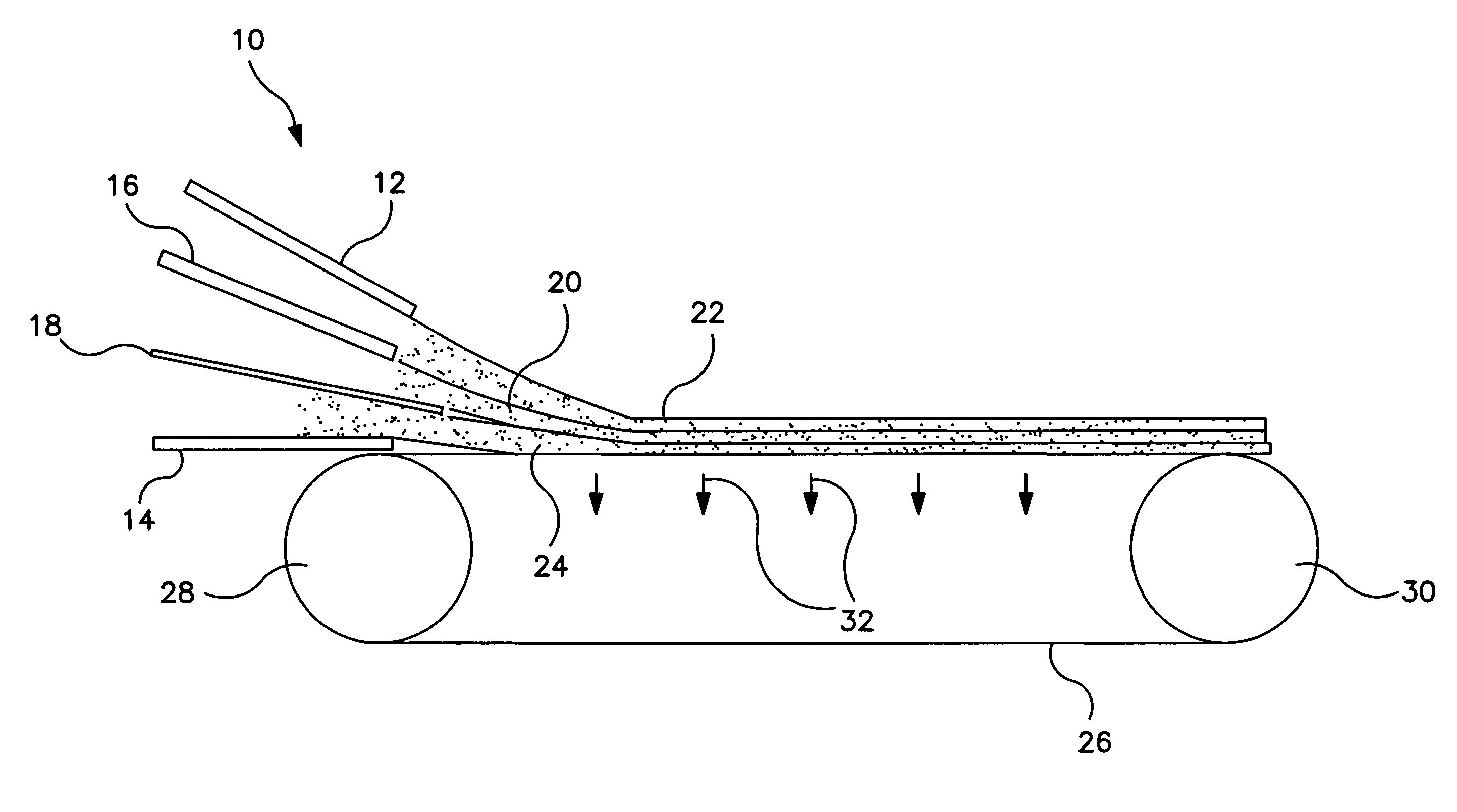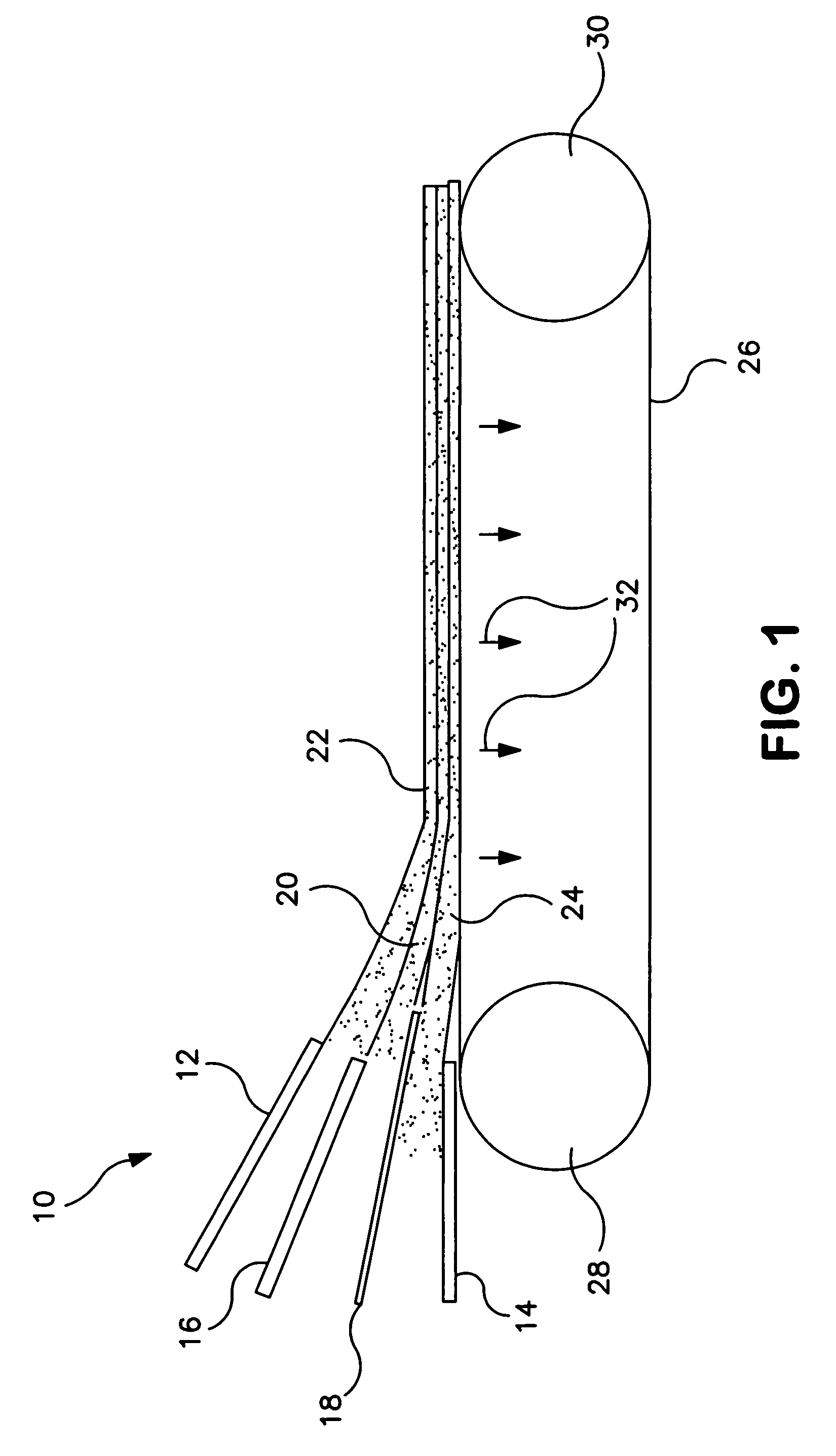Creping process and products made therefrom
a technology applied in the field of creping process and products made therefrom, can solve the problems of adverse effects on the strength of the tissue web, adverse effects on other characteristics of the product, and difficulty in producing a high-strength tissue product, so as to improve the strength of the product without significantly affecting the softness and/or blocking behavior, and increase the strength
- Summary
- Abstract
- Description
- Claims
- Application Information
AI Technical Summary
Benefits of technology
Problems solved by technology
Method used
Image
Examples
example 1
[0133]To illustrate the properties of tissue products made in accordance with the present disclosure, various tissue samples were treated with an additive composition and subjected to standardized tests. For purposes of comparison, an untreated tissue sample, a tissue sample treated with a silicone composition, and a tissue sample treated with an ethylene vinyl acetate binder were also tested.
[0134]More particularly, the tissue samples comprised tissue sheets containing three plies. Each ply of the three ply tissue samples was formed in a process similar to that shown in FIG. 3. Each ply had a basis weight of about 13.5 gsm. More specifically, each ply was made from a stratified fiber furnish containing a center layer of fibers positioned between two outer layers of fibers. The outer layers of each ply contained eucalyptus kraft pulp, obtained from Aracruz with offices in Miami, Fla., USA. Each of the two outer layers was approximately 33% of the total fiber weight of the sheet. The...
example 2
[0151]In this example, additive compositions made according to the present disclosure were printed onto an uncreped through-air dried (UCTAD) base web according to a pattern and creped from a creping drum. The additive composition was used to adhere the base web to the drum. The samples were then tested and compared to an uncreped through-air dried base web that was not subjected to a print creping process (Non-inventive Sample No. 1) and to an uncreped through-air dried base web that was subjected to a similar print crepe process using an ethylene vinyl acetate copolymer (Non-inventive Sample No. 2).
[0152]The uncreped through-air dried base web was formed in a process similar to the process shown in FIG. 2. The basesheet had a basis weight of about 50 gsm. More specifically, the basesheet was made from a stratified fiber furnish containing a center layer of fibers positioned between two outer layers of fibers. Both outer layers of the basesheet contained 100% northern softwood kraf...
example 3
[0165]In this example, tissue webs were made generally according to the process illustrated in FIG. 3. In order to adhere the tissue web to a creping surface, which in this embodiment comprised a Yankee dryer, additive compositions made according to the present disclosure were sprayed onto the dryer prior to contacting the dryer with the web. The samples were then subjected to various standardized tests.
[0166]For purposes of comparison, samples were also produced using a standard PVOH / KYMENE crepe package.
[0167]In this example, 2-ply tissue products were produced and tested according to the same tests described in Examples 1 and 2. The following process was used to produce the samples.
[0168]Initially, 80 pounds of air-dried softwood kraft (NSWK) pulp was placed into a pulper and disintegrated for 15 minutes at 4% consistency at 120 degrees F. Then, the NSWK pulp was refined for 15 minutes, transferred to a dump chest and subsequently diluted to approximately 3% consistency. (Note: R...
PUM
| Property | Measurement | Unit |
|---|---|---|
| volume average particle size | aaaaa | aaaaa |
| particle size | aaaaa | aaaaa |
| temperature | aaaaa | aaaaa |
Abstract
Description
Claims
Application Information
 Login to View More
Login to View More - R&D
- Intellectual Property
- Life Sciences
- Materials
- Tech Scout
- Unparalleled Data Quality
- Higher Quality Content
- 60% Fewer Hallucinations
Browse by: Latest US Patents, China's latest patents, Technical Efficacy Thesaurus, Application Domain, Technology Topic, Popular Technical Reports.
© 2025 PatSnap. All rights reserved.Legal|Privacy policy|Modern Slavery Act Transparency Statement|Sitemap|About US| Contact US: help@patsnap.com



